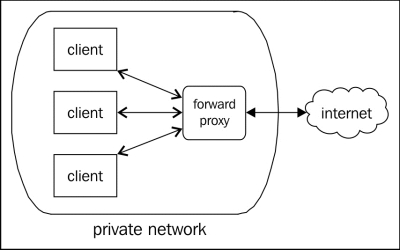Running multiple Node servers
It is easy to purchase several servers and then to run some Node processes on them. But how can those distinct servers be coordinated such that they form part of a single application? One aspect of this problem concerns clustering multiple identical servers around a single entry point. How can client connections be shared across a pool of servers?
Forward and reverse proxies
A proxy is someone or something acting on behalf of another.
A forward proxy normally works on behalf of clients in a private network, brokering requests to an outside network, such as retrieving data from the Internet. Earlier in this book we looked at how one might set up a proxy server using Node, where the Node server functioned as an intermediary, forwarding requests from clients to other network servers, usually via the Internet. Early web providers such as AOL functioned in the following way:

Network administrators use forward proxies when they must restrict access to the outside world...































































